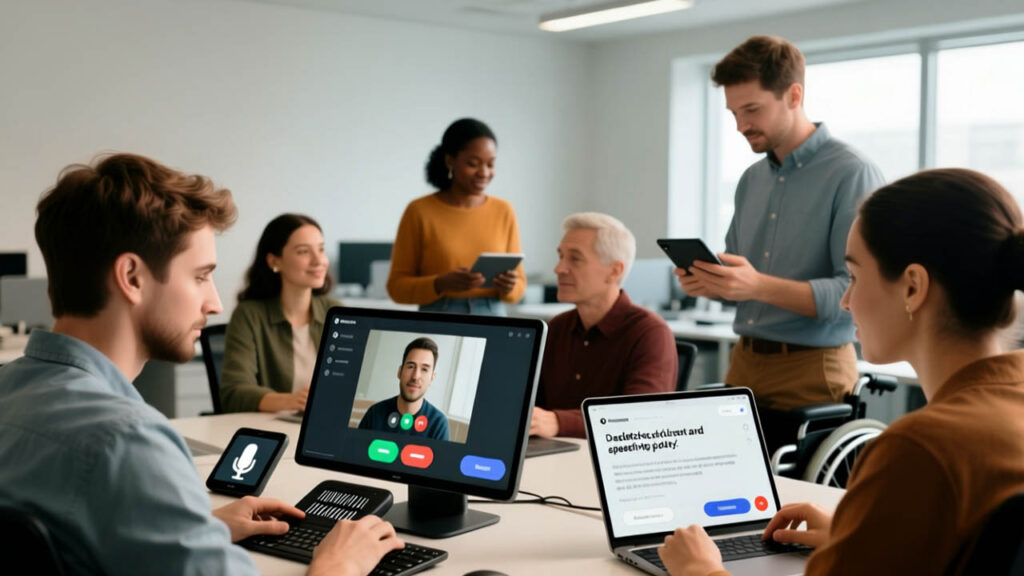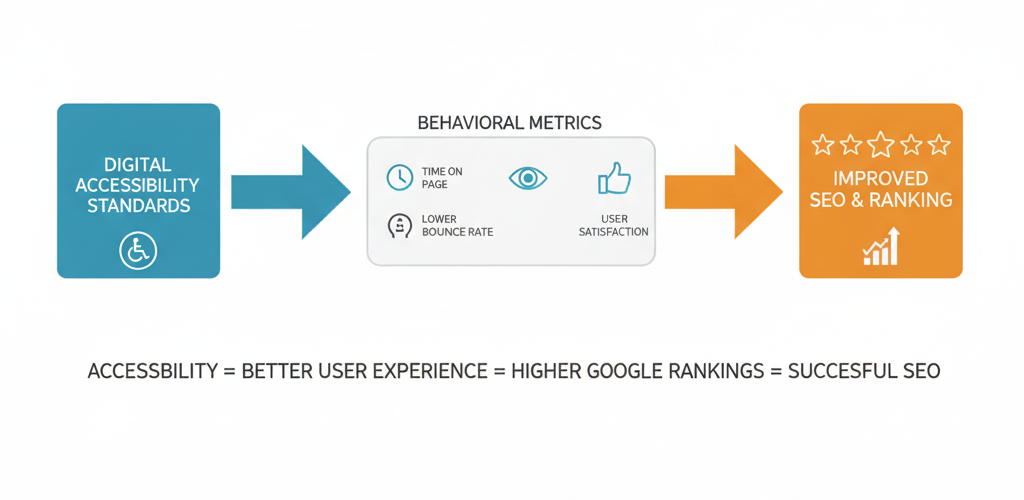
The digital landscape is ruthlessly competitive. Businesses pour millions into complex SEO strategies, chasing Google’s ever-shifting algorithm to earn a top spot. Yet, one of the most powerful, often-overlooked, and fundamentally ethical tools for boosting search rankings and drastically improving core performance metrics sits right in front of them: digital accessibility.
Table of Contents
For too long, digital accessibility has been compartmentalized as solely a legal compliance issue, a costly project, or a “check-the-box” activity. This viewpoint is not only outdated, but it actively costs businesses revenue, market share, and a measurable advantage in search engine results. Adhering to accessibility standards is now a strategic imperative that directly correlates with the signals search engines use to determine quality, relevance, and authority.
The key insight is this: What makes a website accessible to a screen reader or a keyboard-only user also makes it highly “crawlable” and comprehensible to a search engine bot. By designing for the most challenging user experience, you inherently optimize for the best possible experience for everyone, including the algorithm. For any business aiming to secure greater market share, reduce bounce rates, and increase conversion potential, embracing inclusive design is not a cost center—it’s the ultimate, future-proof investment in digital performance.
The Inseparable Link: WCAG and SEO Fundamentals
The modern search engine’s primary mission is to deliver the best possible experience to the user. Google’s algorithms, particularly its focus on User Experience (UX) metrics like Core Web Vitals, actively reward websites that are fast, intuitive, and easy to navigate. The global benchmark for accessibility, the Web Content Accessibility Guidelines (WCAG), defines the best practices for web structure and content. When you solve a problem for the 1.3 billion people worldwide who live with some form of disability, you inherently solve problems for the Googlebot.
The convergence between WCAG success criteria and foundational SEO practices is startlingly clear.
1. Semantic HTML and Content Hierarchy
WCAG Success Criterion 1.3.1 (Info and Relationships): This requires that information, structure, and relationships conveyed through presentation can be programmatically determined or are available in text.
- The Accessibility Requirement: Screen readers (used by the visually impaired) rely on HTML tags like
<header>,<nav>,<main>,<article>, and<footer>to understand the purpose and flow of a page. They also depend on a proper, sequential heading hierarchy (H1, H2, H3, etc.) to allow users to quickly scan and jump to relevant sections. - The SEO Benefit: Search engine crawlers interpret the same semantic structure to determine the main topic of the page and the relative importance of sub-sections.
- The H1 Tag: An accessible page has one, and only one,
<h1>tag, which is the main title. SEO demands the same rule for clear topic definition and relevance signaling. - Logical Flow: A correct hierarchy (H1 followed by H2s, then H3s, without skipping levels) helps Google establish topical authority and break down complex subjects, leading to better eligibility for rich snippets and featured results.
- The H1 Tag: An accessible page has one, and only one,
2. Alternative Text (Alt Text) for Images
One of the most common accessibility failures—missing or poorly written alt text—is also one of the easiest SEO fixes.
WCAG Success Criterion 1.1.1 (Non-text Content): This requires that all non-text content that is presented to the user have a text alternative that serves the equivalent purpose.
- The Accessibility Requirement: The
altattribute must accurately and concisely describe an image’s content or function. This allows screen readers to convey visual information to users who cannot see the image. - The SEO Benefit: Search engine bots cannot see images. They rely entirely on the alt text to understand what the image is about and how it relates to the surrounding page content.
- Image Search Traffic: Alt text is the primary factor in ranking for Google Image Search, a massive and often untapped source of organic traffic.
- Contextual Relevance: Descriptive alt text reinforces the page’s main topic, strengthening its relevance for target keywords, effectively turning your images into high-ranking content assets. Justin Morgan, Dental Marketing Guy, expert in dentistry SEO, recommends to include alt text such as “white-tooth smile after successful cleaning and whitening treatment” for an image of a person with a bright smile. This not only describes the image accurately but also includes relevant keywords for dental services.
3. Transcripts and Captions for Multimedia
WCAG Success Criterion 1.2.1 (Audio-only and Video-only Pre-recorded) & 1.2.2 (Captions Pre-recorded): These criteria require text alternatives (transcripts) for audio/video, and synchronized captions for video content.
- The Accessibility Requirement: Transcripts and captions ensure that users who are deaf, hard of hearing, or have cognitive disabilities can access the information presented in multimedia.
- The SEO Benefit: Video and audio files are virtually invisible to search engines without text. Providing a full, searchable transcript gives Google thousands of words of indexable content—far more than a short video title or description. This dramatically increases the page’s topical keyword relevance and ability to rank for long-tail queries.
The Critical SEO Metrics That Enhance Digital Accessibility
Beyond technical conformity, accessibility improvements directly influence the behavioral metrics that Google uses as a proxy for content quality and user satisfaction.

A. Core Web Vitals (CWV)
CWV is a set of quantifiable metrics used by Google to measure the real-world user experience of loading speed, interactivity, and visual stability. Accessibility principles naturally align with improving these scores:
| Core Web Vital | Definition | Digital Accessibility Alignment |
| Largest Contentful Paint (LCP) | Measures loading performance (when the main content loads). | Accessible design prioritizes clean, lean code and simple visual hierarchy, often leading to faster initial load times for all elements. |
| First Input Delay (FID) | Measures interactivity (the time until the browser can respond to user input). | Accessible interfaces minimize code bloat and complex scripting that can slow down responsiveness, thereby lowering FID. |
| Cumulative Layout Shift (CLS) | Measures visual stability (unexpected shifts in page layout). | Accessible design requires consistent, predictable layouts (WCAG 3.2.3 Consistent Navigation), which prevents the content shifts that trigger a poor CLS score. |
B. Lower Bounce Rates and Higher Dwell Time
Keyboard navigation and clear content structure, as detailed earlier, are the unsung heroes of engagement metrics.
- WCAG Success Criterion 2.1 (Keyboard Accessible): Every interactive element must be reachable and operable using the Tab key. A site with a logical tab order and clear focus indicators is a fully functional site for everyone.
- The Engagement Effect: When a website is immediately usable—no confusing menus, no unclickable buttons, no tiny text—all users find the information they need quickly and easily. This directly results in:
- Lower Bounce Rate: Users are less likely to click the ‘back’ button in frustration.
- Increased Pages Per Session: Users can smoothly move to the next piece of content, leading to deeper site exploration.
- Higher Dwell Time: Engaged users spend more time consuming content.
These three factors are incredibly strong positive signals to Google that your website is a high-quality, authoritative resource for the search query.
The Undeniable Business Case: Beyond SEO
While the SEO benefits alone justify the investment, accessibility is a foundational business strategy that drives growth across multiple departments.
1. Market Expansion: The $13 Trillion Opportunity
Ignoring digital accessibility means actively excluding a massive, global demographic known as the “disability economy.”
- Over 1.3 billion people worldwide live with some form of disability.
- The global disposable income of people with disabilities is estimated to be over $13 trillion annually, when factoring in their friends and family.
Businesses that prioritize inclusive design gain access to this enormous, loyal, and consistently underserved market. Moreover, accessible features benefit everyone: captions are great for a busy commute, high contrast is ideal in bright sunlight, and a clear content hierarchy is perfect for users skimming content on a small mobile screen.
2. Legal Risk Mitigation
The legal landscape is tightening globally. The Americans with Disabilities Act (ADA) in the U.S. continues to drive a high volume of web accessibility lawsuits, treating an inaccessible website as a denial of public accommodation. Furthermore, the European Accessibility Act (EAA), which comes into full force in June 2025, sets mandatory digital accessibility standards for digital products and services across all EU member states.
Proactive investment in accessibility is significantly less expensive than reactive legal defense, settlement fees, and emergency remediation efforts required after a lawsuit. Digital Accessibility is insurance against catastrophic brand and financial damage.
3. Brand Reputation and Loyalty
Modern consumers—particularly Gen Z and Millennials—actively seek out and reward brands with strong Corporate Social Responsibility (CSR) policies. When a company showcases a commitment to inclusivity by making its products accessible, it builds trust and fosters powerful brand loyalty. Accessibility moves a brand from merely compliant to ethically innovative.
Implementing a Dual SEO-Accessibility Strategy
Achieving and maintaining accessibility is an ongoing commitment, not a one-time project. It requires consistent auditing and training.
Practical Steps for Implementation
| SEO/WCAG Principle | Implementation Action | Business Outcome |
| Structure (WCAG 1.3.1) | Use correct HTML semantics; one H1 per page; structured data/Schema markup. | Higher crawl efficiency; better snippet visibility; clarity for screen readers. |
| Media (WCAG 1.1.1, 1.2.2) | Add descriptive Alt Text to all meaningful images; provide synchronized captions and full transcripts for videos. | Increased organic traffic from Image Search; higher relevance for video content; access for hearing-impaired users. |
| Navigation (WCAG 2.1) | Ensure all elements are keyboard-operable; provide clear focus indicators; include a “Skip to Content” link. | Lower bounce rate; increased dwell time; accessible for users with motor disabilities. |
| Readability (WCAG 1.4.3) | Use a minimum 4.5:1 color contrast ratio; write in plain, concise language. | Improved UX for all users; reduced eye strain; better content comprehension and readability scores. |
A company dedicated to technical excellence and seamless user experience, such as Horlix, understands the need for a functional digital presence that serves every user from the foundation up. As businesses prioritize technical integrity to win the SEO race, they naturally move closer to an inclusive digital model. The principle is simple: clean code is accessible code, and accessible code is SEO-friendly code. To ensure your digital platform meets the highest standards of performance and inclusion, you must build from an accessible core. You can learn more about building a robust digital foundation by clicking the button below
The Final Verdict
The era of trying to game search engines is over. Google and other major search providers are relentlessly focused on one thing: a superior user experience. Digital accessibility, guided by the foundational principles of WCAG, is the highest standard of user experience.
By integrating accessibility into your design and development process from the start, you are not just fulfilling an ethical and legal obligation; you are aligning your entire digital strategy with the very metrics that drive modern search engine rankings. Companies that lead with inclusion will inevitably lead the rankings, securing long-term organic growth, brand loyalty, and a competitive advantage that cannot be ignored. Digital accessibility is not just the right thing to do—it’s the smartest business move you can make today.